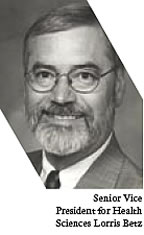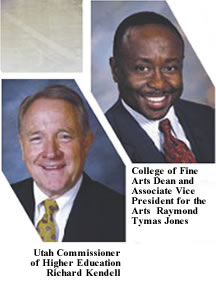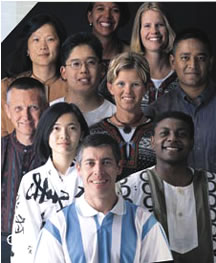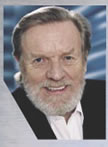
Vol. 16 No. 1 |
Summer 2006 |

Fifteen years ago, the Human Genome Project was in its early stages. The project was unfathomably ambitious; its goals were to identify all of the 20,000-25,000 genes and determine the sequences of the three billion chemical-base pairs that make up human DNA. Coordinated by the U.S. Department of Energy and the National Institutes of Health, the project soon broadened to include an international component, with partnerships and contributions coming from universities and private industry in many different countries.
The Human Genome Project, which included efforts from the University of Utah’s Eccles Institute of Human Genetics, was supposed to have taken 15 years.
It took 13.
 The
project wrapped up in 2003, two years early, thanks to unprecedented advances
in technology. In less than 15 years, the entire human genome was mapped,
accelerating the field of biomedicine well beyond predictions. The ripple
effects around the globe are, and will continue to be, staggering.
The
project wrapped up in 2003, two years early, thanks to unprecedented advances
in technology. In less than 15 years, the entire human genome was mapped,
accelerating the field of biomedicine well beyond predictions. The ripple
effects around the globe are, and will continue to be, staggering.
This is only one example of what can happen in a mere 15 years. When it comes to educating students, the next decade and a half will be crucial for the University of Utah. Administrators and strategists are already setting the wheels in motion to re-energize and refocus the University’s role as innovator and educator. Sure, some things will never change because they’re the hallmarks of a positive university experience—direct and personal interaction between faculty and students, for example. But in 2021, how will the U’s approach to education be different from that of today? And where will the next 15 years take us?
Regardless of the answers to these questions, one thing is certain: The University of Utah will not be content to sit on the sidelines, merely reacting to changes.
The world is changing too rapidly and the amount of information available is proliferating too dramatically for universities to trudge along at a decades-old pace.
U of U President Michael K. Young thinks less in terms of where the future will take the University than how the University will shape that future. In his vision, there is no room for passive involvement. The world is changing too rapidly and the amount of information available is proliferating too dramatically for universities to trudge along at a decades-old pace.
And President Young’s vision for a dynamic, changing University—which he has voiced many times, beginning with his inaugural address in April 2005—is infectious. All across campus, a call for greater emphasis in four areas—research, technology, interdisciplinary studies, and globalization—is heralded by administrators, faculty, and staff.
RESEARCH
The U is categorized by the Carnegie Foundation as RU/VH: Research Universities
(Very High Research Activity). Vice President for Research and Professor
of Genetics Ray Gesteland believes that the current level of research
conducted at the U pales in comparison to what’s coming down the
pike.
 Traditionally,
research has been the domain of graduate students, but that is changing.
Cutting-edge offerings such as the Undergraduate Research Opportunities
Program, which provides undergrads the chance to work with faculty on
research or creative projects with the potential for real impact, affords
every student the chance to put his or her education to work, beginning
Day One. “We have a lot of undergraduates involved in research now,
and that’s really what makes education at a research university
so valuable,” says Gesteland. He anticipates increasing research
involvement by both undergraduates and graduates, especially in fields
such as nanotechnology.
Traditionally,
research has been the domain of graduate students, but that is changing.
Cutting-edge offerings such as the Undergraduate Research Opportunities
Program, which provides undergrads the chance to work with faculty on
research or creative projects with the potential for real impact, affords
every student the chance to put his or her education to work, beginning
Day One. “We have a lot of undergraduates involved in research now,
and that’s really what makes education at a research university
so valuable,” says Gesteland. He anticipates increasing research
involvement by both undergraduates and graduates, especially in fields
such as nanotechnology.
“Energy is another field of research that will be important,” he says. “We’ll be researching better ways to use existing energy resources as well as new energy alternatives.”
Gesteland also expects to see continued breakthroughs in computer technology and in biomedicine. “Fifteen years from now, all of the Human Genome Project information will have a huge impact on medical care,” he says. “Everyone who goes into a clinic will have his or her genome sequenced. The ability to diagnose will be very different.”
 Senior
Vice President for Health Sciences Lorris Betz echoes Gesteland’s
predictions: “The changes in the health sciences in Utah over the
next 15 years will be based upon further evolution of recent remarkable
medical advances. A tremendous expansion of genetic information will be
applied to individuals to create truly ‘personalized’ medicine.”
Ultimately, a patient’s individual genome sequencing could allow
doctors to identify medicines unique to that person. And the U will be
at the forefront of the medical revolution, as it has been since the School
of Medicine’s founding 100 years ago.
Senior
Vice President for Health Sciences Lorris Betz echoes Gesteland’s
predictions: “The changes in the health sciences in Utah over the
next 15 years will be based upon further evolution of recent remarkable
medical advances. A tremendous expansion of genetic information will be
applied to individuals to create truly ‘personalized’ medicine.”
Ultimately, a patient’s individual genome sequencing could allow
doctors to identify medicines unique to that person. And the U will be
at the forefront of the medical revolution, as it has been since the School
of Medicine’s founding 100 years ago.
Along with personalized medicine, Betz sees growing opportunities for research and development in areas such as biomedical informatics, neurosciences, biomedical engineering, genetics, population-based research, and targeted drug development.
TECHNOLOGY
Think back to the computer on your desk 15 years ago. Technology has expanded
and improved exponentially in recent years, and the pervasive role of
technology in every field of study at the University of Utah is growing.
That means each college and department will be integrating new advances
into its research and pedagogy. By 2021, the gadgets and methods for delivering
information of 2006 will seem as antiquated and quaint as that computer
you used in 1991.
In the health sciences, technology will continue to improve everything from diagnostics to prosthetics. But it will also play a vital role in managing medical information. “The development of electronic medical records and medical information management systems will lead to better and safer medical care through the development and application of evidence-based best medical practices,” says Betz. There will be more computer-based, individualized learning. And, he adds, “national repositories of computer-based tools will lead to more standardization of the curricula of schools across the country.”
“We’re training students not for their first job, but for a life. We’re training them to be leaders—business leaders, political leaders, community activists. We’re training them to transform the future.”
—President Michael K. Young
Technology will have multiple impacts on athletics at the University, too. Technology is continually improving sports training and monitoring. But it will also change how fans access information. “You’ll be able to view more sports over the Web,” says Athletic Director Chris Hill MEd’74 PhD’82. As non-traditional sports gain in popularity, the Internet will play a greater role in delivering those sports to viewers—Ute fans worldwide will be watching the school’s pistol or rugby team in action. As technology advances to create a world in which the user determines what to watch, when to watch, and which entertainment or information to exclude from his or her life, these smaller, less visible sports will reach more targeted, niche audiences.
 The
arts will also be affected by technology. “Digital arts and media
digitalization will have a tremendous impact on the arts,” says
Dean of the College of Fine Arts and Associate Vice President for the
Arts Raymond Tymas-Jones. “The ubiquitous nature of technology will
certainly affect all of the arts, in terms of its influence on new art
forms and consequently our understanding of its pervasive nature through
the scholarship of critical theory and history.” It may become commonplace,
for example, for performers in Brazil to collaborate with dancers or musicians
at the University of Utah, linked via the Internet to create dazzling
new collaborative pieces.
The
arts will also be affected by technology. “Digital arts and media
digitalization will have a tremendous impact on the arts,” says
Dean of the College of Fine Arts and Associate Vice President for the
Arts Raymond Tymas-Jones. “The ubiquitous nature of technology will
certainly affect all of the arts, in terms of its influence on new art
forms and consequently our understanding of its pervasive nature through
the scholarship of critical theory and history.” It may become commonplace,
for example, for performers in Brazil to collaborate with dancers or musicians
at the University of Utah, linked via the Internet to create dazzling
new collaborative pieces.
Learning itself will be enhanced by technology. According to Commissioner of Higher Education Richard Kendell MEd’70 PhD’73, education will become more individualized in the future. Because of budget constraints, he says, “we will still have large classes and large lab sizes. You won’t get a lot of individualization that way. But the technology certainly allows for individualization.” Many students are already taking online courses because the traditional courses don’t fit their schedule. “Courses and tutorials are available 24/7. There are links to access information from virtually all over the world,” says Kendell. “Those networks allow for individual interests, research, and study that were unheard of just a few years ago. I think that will increase.”
An education at the U, then, will be more tailored to the individual’s lifestyle. Naturally, there will still be requirements and prerequisites, as the core of a university education requires exposing students to a variety of fields and subjects. But the manner in which information and research within those diverse fields is collected, disseminated, and offered to students will most likely expand and change.
 |
As
associate vice president for inter-disciplinary studies (and dean
of the College of Humanities as well), Robert Newman
is always on the prowl for new and creative ways to bring together
various departments and colleges at the U. “There are some
natural alliances on campus, and we’re building on those,”
he says. |
INTERDISCIPLINARY
STUDIES
Of all the new ideas being implemented at the University of Utah, the
concept of interdisciplinary studies may be the most radical, yet the
most practical. Blending students and faculty from multiple disciplines
to tackle a complex issue is an idea whose time has finally come. Challenges
to a community or a society do not typically fall under one category such
as “business” or “engineering.”
“In an environmental class working on the effects of global warming,” says President Young, “the class could contain science students measuring the effects of global warming, urban planning students determining how communities would be affected, transportation engineering students working on the ramifications for transportation, and economics students studying the cost and how it would affect the job market.”
As the world becomes more complex and interconnected, university disciplines can no longer remain separated by rigid definitions. “The economist has to understand engineering. The ethicist has to understand biology. The scientist has to understand ethics,” explains President Young. And the cross-germination of ideas and differing points of view arising out of conversations between the economist and the engineer will yield solutions to problems previously thought unsolvable.
Currently, the U is leading the charge in plans to offer interdisciplinary courses and majors. The College of Humanities recently inaugurated a graduate program in Environmental Humanities, a study of the environment through history, science, literature, and ethics that has received wide acclaim and interest. And in the Honors Program, students from across the disciplines have been participating in “Think Tanks,” analyzing and studying pertinent community problems within a range of fields. In some ways, interdisciplinary studies reflect the tried and true ideas of “liberal education,” but interdisciplinary studies will (and do) have a 21st century twist: it’s far more involved, and makes use of technology and collaboration. So by 2021, interdisciplinary studies at the U will be commonplace, spanning every college on campus.
As more departments look to form alliances to make their students’ education more relevant and purposeful, interdisciplinary projects are cropping up everywhere. Chris Hill expects to see increasing partnerships between the athletics and the health sciences departments, expanding in areas of sports performance as well as in sports injury prevention and recovery.
Betz sees the amount of health-related research and education increasing in departments outside of health sciences. “Interdisciplinary collaboration is an essential ingredient for progress in biomedical research,” he says. “There are many fundamental issues in medicine that require ethical, legal, social science, engineering, and business expertise.”
Associate Vice President for Interdisciplinary Studies and College of Humanities Dean Robert Newman lays the groundwork for new courses and programs, pulling together faculty, deans and vice presidents for discussions on how to best break down barriers separating the disciplines. Newman recognizes that in order for students to tackle tomorrow’s problems, they must grasp how the arts, sciences, and everything in between are connected. “It’s extremely helpful for students to learn how the disciplines are related,” he says.
GLOBALIZATION
AND DIVERSITY
 |
|
A
Snapshot of the Student Body What about the students in 15 years? How will they differ from the U’s current population of 29,000 scholars? First, the U can expect a marked increase in the number of young Utahns interested in higher education. The state currently has more than 450,000 K-12 students, but in 15 years that number could climb to 600,000. Administrators say the University of Utah student of 2021 will arrive better prepared than ever for college. Over the coming years, the U’s entrance standards will be raised, and state high school classes will become more rigorous to meet those standards. And chances are good that students will have attended at least one other college before landing at the U. “They will have been multi-tasking at an unimaginable rate their entire lives,” says Barbara Snyder, vice president for student affairs. Among those multi-taskers will be a greater number of minority students. Currently, the number of Hispanic and Asian students at the U is growing faster than any other ethnic group, and minority students at the U are predicted to increase from between 9 to 10 percent in 2006 to 20 percent by 2021. All of these students will come to the U with high expectations of getting information the way they’ve become accustomed to getting it—through multiple platforms, and fast. “Teaching methods will be in constant flux,” Snyder says, “and administrators will have to run hard to keep up with the students’ demands.” |
Take two groups of people. In the first group, everyone looks the same, comes from the same background, and thinks alike. The chances of that group’s coming up with a breakthrough idea is slim. The other group is a hodge-podge of people from different backgrounds who don’t look, think, or act alike. Let them start bouncing ideas off of each other, and the sky’s the limit.
President Young is convinced that diversity is the key to strengthening the educational experience. “Students learn from each other,” he says. “The more diversity we have on campus, the better our education becomes.” Not content to wait for the state’s demographics to change, he wants to encourage more diversity in both the student body and the faculty. That means promoting the hiring and retention of professors and instructors from a variety of backgrounds, and instituting programs, scholarships, or incentives to attract a diverse student body. Plans in these areas have been in the works for some time, but will gain traction in coming years, so that by 2021, the demographic makeup of the U’s faculty and students should be more varied.
Globalization expands the concept of diversity beyond national borders. U.S. business, economics, and politics are inextricably woven into world business, economics, and politics, and university graduates must be prepared to thrive in a globally connected environment. President Young envisions a University in 15 years that has incorporated more international elements at every level. “Students from different countries may attend University classes while still in their home countries, using technology to engage in semester-long conversations,” he says. “Communication may even be holographic by then.”
As another example, he imagines an interdisciplinary class studying the environmental issue of clean water.
“They might spend part of the semester discussing clean water in other countries—not just Utah. Then they might spend the second part of the semester in that country, realizing the social and political impediments to implementing those ideas they had in class.”
Hill sees diversity and global awareness affecting the University’s athletics programs in the coming years. He believes women’s sports have room to grow, and foresees increasing interest in them. In addition, he says, “We’ll see more and more international athletes on our teams. The world is getting smaller, and the U.S. has a great higher education program. In many other countries, sports aren’t attached to universities. So this is where people will come who want to get a degree and participate in their sport.”
In the arts, Dean Tymas-Jones anticipates significant world influences. Artists and performers will more readily draw inspiration from sources beyond U.S. borders, and works will reflect those international flavors. “The distinctiveness of different cultures will influence what we’ve historically known to be ‘American.’ The concept of the global village will be more rooted in what we do,” he says.
PREPARING FUTURE STUDENTS FOR THE FUTURE
One such guru is U of U alumnus John Naisbitt BA’52. He analyzes the forces at work shaping our world and offers various scenarios for what to expect. This isn’t tea leaves and Tarot cards; Naisbitt’s books, including 1982’s bestseller Megatrends, have become highly influential texts in business and economic circles. So how does Naisbitt believe the American university will look and feel by 2021? Surprisingly, pretty much like the university of 2006. “I think we might have a little more on-line education by 2021,” he says, “but then that is second-rate education at best. For me the purpose of education is to teach students how to learn, and we ought to work on doing a better job at that, so they can enter into a life-long adventure of learning.” But that doesn’t mean it’s business as usual for the next 15 years. To be ready for the university of the future, everyone should be brushing up on a foreign language, as Naisbitt cites the single most important trend influencing higher education in the next decade and a half: “Overwhelmingly, globalization. Both student bodies and faculties will become more international. Outsourcing of students and faculty, both electronically and physically, should greatly increase, with an increasingly global mix that should benefit almost everyone.” Naisbitt also believes that higher education in the U.S. is uniquely poised to take full advantage of globalization. “The American higher education system is the strongest in the world because it is a competitive system—more than 4,000 colleges and universities competing for students,” he says. “Here in Europe where I live there is no competition among universities, and all 2,000 of them are going down hill.” |
With technology and knowledge expanding by orders of magnitude, current information about almost any topic has, at best, a temporary value. But the ability to gather, analyze, and understand information—no matter how current—is timeless. Says President Young, “The fundamental purpose of a university is to enable people to think deeply and critically. Skills narrowly defined will become obsolete eventually. There’s a need to move forward, but we can’t lose sight of the basics.” In many ways, the student strolling across campus in the fall of 2021 will have many of the same experiences as those in 2006. The U has been successful with retaining those elements of a classical education that create a lasting impact, looking to the successes and theories of the past to forge a curriculum that matters today. Yet the University has been equally skilled at looking ahead.
By championing research, technology, interdisciplinary collaboration, and globalization, President Young and the entire University of Utah community are molding an educational experience that will keep future students current with the state of knowledge, while building their critical thinking skills to propel them forward. “We’re training students not for their first job, but for a life,” says President Young. “We’re training them to be leaders—business leaders, political leaders, community activists. We’re training them to transform the future.”
—Kelley J.P. Lindberg is a freelance writer based in Layton,
Utah
 |
Bricks and Mortar: Planning for the U's Physical Growth In 1997, the University developed a “Long Range Development Plan” to manage campus growth for the next 20 years or so. Periodically, campus planners revisit and update the plan, as they last did in 2003, to make new recommendations and adjustments. “It’s probably time to update it again, since it’s been a few years since the last one, and it would be best if it reflected the direction for the institution as envisioned by our new president,” says Associate Vice President for Facilities Management Mike Perez. Perez says that a campus “master plan” is not set in stone; rather, he calls the plan a “snapshot” of how the campus might develop. It’s a fluid plan, designed to evolve with new technological developments, traffic patterns—and the visions of new University presidents. The LRDP takes a slow and steady approach to developing the campus, with an eye toward crafting a more effective learning environment, including preserving the U’s bucolic setting. “We want to maintain those open spaces and view corridors,” Perez says. Perhaps the most visible campus development in recent years (aside from TRAX) is the Warnock engineering building, scheduled for completion next fall. But, according to planners, there are even bigger changes afoot. Some years down the road, sections of campus will be reconfigured to facilitate improvements in interdisciplinary research and scholarship. For example, grouping the sciences, engineering, and computing facilities in proximity could, in theory, help to foster collaboration among those disciplines. Such goals for the humanities will be more easily integrated with the completion of a new building planned to occupy land south of the Sill Center. The David Eccles School of Business will be getting a facelift, thanks to a challenge grant from the George S. and Dolores Doré Eccles Foundation. And recent funding for the Utah Science, Technology, and Research initiative (USTAR) paves the way for a new research facility likely to be situated where the old dormitories once stood. By 2021, nationally renowned researchers should be elbow-deep in new discoveries at the USTAR facility. It might seem as if the U has limited space to grow, but the golf course has long been considered a “land bank,” and campus planners believe that they will be drawing on that space in coming years. Perez notes the difficulty of managing growth spurred by innovation. “It’s a good problem to have,” he says. “We’re one of a number of institutions challenged just by our vibrancy.” Nowhere is that more evident than at health sciences, where explosive growth has maxed out most facilities. Building 521’s (the old hospital) days are numbered: At some point in the near future, it will be demolished to make way for a new facility. |
 No
Crystal Ball Needed—Just Look at the Trends
No
Crystal Ball Needed—Just Look at the Trends